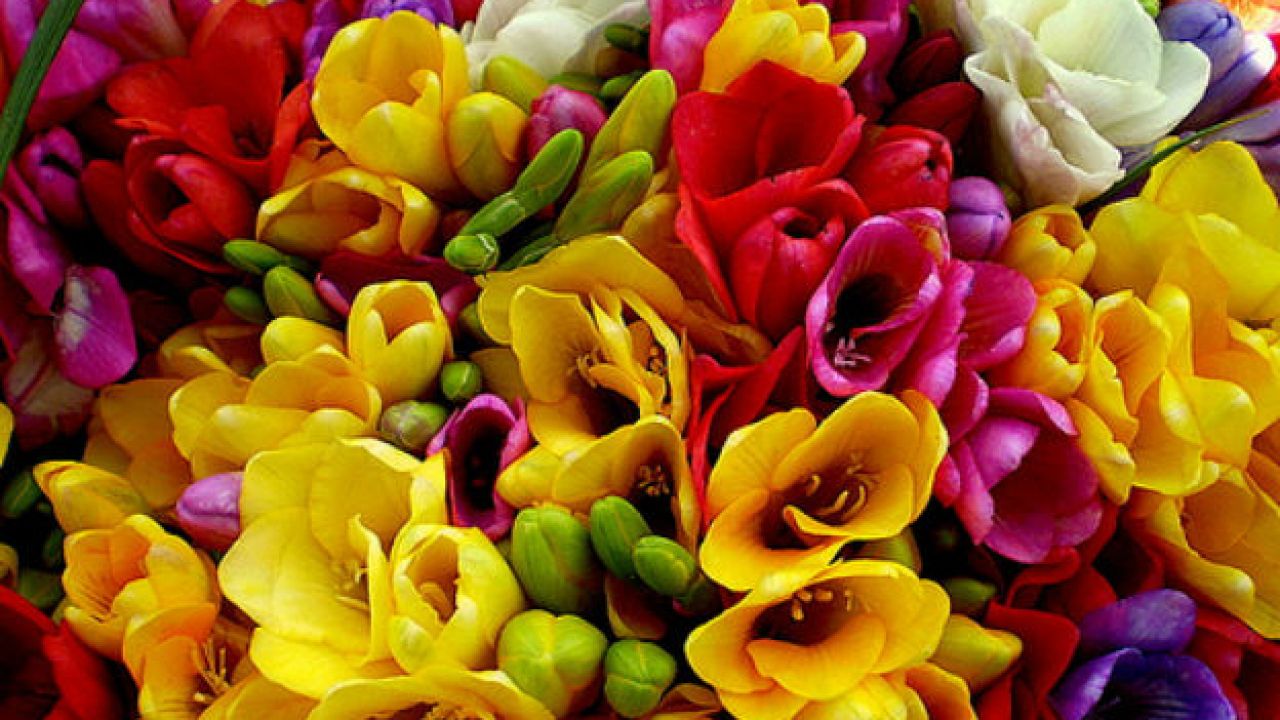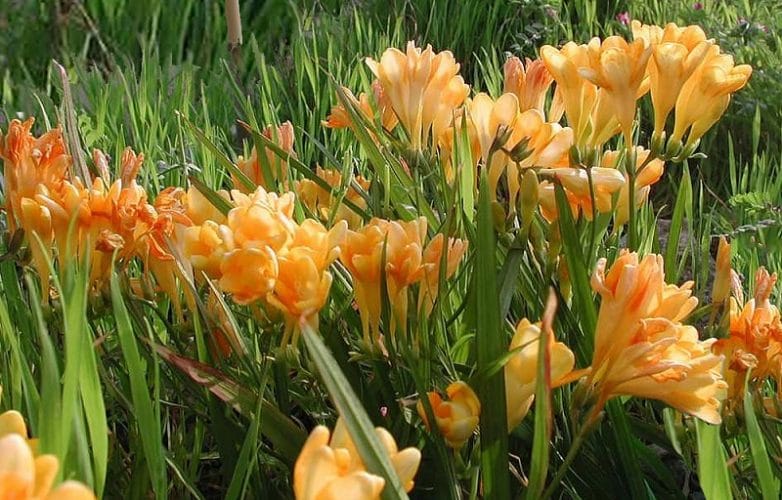Freesia is a plant with trumpet-shaped flowers on stems. They stand out for their pleasant fragrance and great color, in addition, they are highly appreciated for their use in flower arrangements. They are grown in the garden or in pots, and must be provided with moist, well-drained soil, preferably exposed to the sun. Read on to discover what Freesias are like and their care.

How are the Freesias?
It is a very fragrant and striking native African flower for its yellow, red, pink, orange, bluish and purple colors, which can produce five to seven tubular flowers per stem and reach a size of 30 to 60 centimeters when exposed to the sun. tall, their growth is favorable when exposed to the sun, but they still tolerate a planting place that receives a little shade. They are sown by prepared bulbs outdoors in April for late summer bloom or can be grown in a cool greenhouse for spring bloom.
Freesia stems are thin and cannot always support the weight of the flowers, especially in varieties that produce double flowers. A growing stake system that has a grid to hold the flowers and leaves will keep the plants upright. In addition, they are essential for a cut garden, from which the flowers can be disposed of when the first flower on the stem opens and the rest begin to show color. When cut, they can last approximately 12 days in a vase with water.
How to grow Freesias?
Considering that Freesia bulbs enter their growth phase during the fall, they should be planted at this time of the year in a sunny spot in the garden with rich soil, ideally a sandy garden loam modified with humus or compost. As the bulbs are small they do not require deep planting, just place them pointed end up, 5cm deep and 5-10cm apart, forming groups of at least 5 or 7, so they look best during flowering , which should occur in 12 weeks usually.
Freesias are not cold hardy flowers and require night temperatures of around 10 to 55 degrees to form buds. However, it can be noted that if you do not have access to a cool greenhouse you have to move them in containers to an unheated garage or shed every night. Also, freesias prefer about 40% to 50% humidity, which can be difficult to provide in dry climates. In turn, it is necessary that once the first shoots emerge from the soil, apply a balanced floral fertilizer, this should be repeated during the rest of the growth stages and keep the plants in full sun.
Indoor or greenhouse planting
Indoors, the bulbs will flower from January to April if planted between August and December. Ideally, an October planting should flower in March for a period of four to five weeks. Space the bulbs 5 to 8 centimeters apart with the tips sticking out of the ground. Water after planting and place them in a cool, frost-free place, such as a cold frame, at 5 degrees Celsius for about a month. Then transfer the pots to a greenhouse or cool space with a temperature of 10 to 15 degrees Celsius for the winter.

Provide enough light and ventilation, and do not let them dry out. Support the growing plant support with twigs or wire mesh as stems develop. Apply a mixture rich in potassium every fortnight from the first outbreaks. After flowering, cut off faded flowers and continue watering and feeding until foliage begins to wilt. Compensation will be promoted in 2 months. It's also important to know that if it continues to grow for a second year, the foliage should dry out by early July.
What are the cares?
Ensuring well-drained soil is key to its growth, so care should be taken to have suitable, well-fertilized soils for plant nutrition and to improve drainage. Regarding the supply of water that the plant requires, keep the soil moist but not soggy as new shoots grow, it is recommended that watering be done once a week once they are flowering, then it should be reduced to allow the soil dries out when the foliage turns yellow and begins to wilt.
Freesias are not cold hardy flowers and are usually planted in early spring as annuals in areas outside of their growing zone. However, plants need night temperatures around 10 degrees to form buds. If you don't have access to a cool greenhouse, move them in containers to an unheated garage or shed every night. Also, freesias prefer about 40% to 50% humidity, which can be difficult to provide in dry climates.
In attention to the above, if you notice that despite the care you take, the plants still do not bloom, keep in mind that Freesias require conditions like those of their native region, so they must be protected from high temperatures at all times. winter, so you will need to remove them from the ground and plant them in containers to protect them from winter temperatures. Another reason to take precautions is possible heat damage, since in areas with high temperatures they can cause extremely thin stems and flowers that quickly fade or even not bloom because they need to break dormancy.
Comprehensive pest and disease control is also important for the successful cultivation of freesias, as they are generally susceptible to aphids, caterpillars and red greenhouse mites, rodents and voles. In addition, they can exhibit what is known as Fusarium bulb rot, Freesia mosaic virus, and gladiolus dry rot fungus, Sclerotinia, which causes root rot and fluffy white mold on the stems. affected parties.
Freesia Propagation
To propagate Freesia flowers you first have to remove dormant bulbs from the ground in the summer, this is made possible by corm offsets. Then plant and care for them as you would mature bulbs. But keep in mind that flowering may not start until a season or two later. Another method of propagation is to grow from seed in about seven to eight months, but they may not flower for some seasons.
This latter breeding procedure involves carrying out a series of steps beginning with allowing the seed pods to mature on the plant after flowering, which usually occurs in the summer. Once they are brown and have formed vertical lines they have to be collected and dried in a paper bag for a few days. After the largest seeds have been selected, they should be covered with warm water and allowed to soak for a day, in order to soften their hard coat before sowing.
They should then be expected to germinate in the dark with background heat between 13 and 18 degrees Celsius. Another step is that aluminum foil should be placed on top of the container that was selected to obtain more plants, and you have to wait for the time it takes for the seedlings to appear. The care in this phase is also important to prevent them from drying out and being able to go on to the vegetative phase, always maintaining the appropriate conditions of moderate irrigation, humidity and temperature.
Types of Freesias
There are many species of the genus, among which are the Belleville, which are characterized by having double white flowers. Other Freesias that enchant are the Golden Passion, since they have up to 10 yellow flowers per stem. There are also those known by the name of Oberon, which are distinguished by having bright red and yellow bicolor flowers. In addition, those of the Royal Blue type are mentioned, which is a variety with white flowers and delicate purple tones. Other types of this herbaceous plant that sprout from a corm, which you can cultivate and care for as explained in this article, are mentioned below:
Speedy White – Elegant and delicate, this flower has crisp white petals around small contrasting yellow centers. It is common for them to occupy a special place in terms of decoration. Pink Attraction: Feature curly light pink to dark pink petals, creating a rich, multi-layered bloom. Delicately blending pink with delicate white hues and proudly sporting shiny leaves, this type of Freesia is ideal for engagements and weddings. Corvette Freesias: They give off a wonderful aroma, through their large white petals arranged in layers.

Red Beauty: One of the remarkable aspects of this type of Freesia is its strong and sweet smell. It produces bright red double flowers with yellow reflections at the base of each petal. Freesia Vienna – Has creamy white petals that fade to a very light beige towards the center meaning you can plant them alongside other colored flowers and they will complement each other beautifully. They make beautiful border plants and are also low maintenance.
Continuing the relationship between the wide variety of freesias, it is worth noting, the one called Dawn: which have bright yellow petals, bright yellow centers and a subtle shade of white near the center. There is also Sandra: which is an extraordinary type of Freesia, which has intense pink petals and yellow and white centers. Pink attraction: whose petals are a whitish pink with a raspberry rim, and the petals wrap around each other so that the center is practically hidden.
For its part, the Panda Freesia is striking because its petals are raspberry pink with white near the bright yellow center, they grow up to 45 centimeters in height. Finally, the type of Freesia called Bordeaux is presented: whose petals are very dark red and have bright yellow centers, as well as touches of light white near the center. The color makes this plant very striking and it looks fantastic when planted near white or lighter colored plants, including other freesias.
If you liked this article on How are Freesias and their Care, we invite you to read other articles that contain topics of interest in the following links: